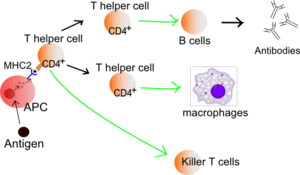Danger model
The Danger model is a theory of how the immune system works. It is based on the idea that the immune system does not recognize between self and non-self, but rather between something that might cause damage.

Brief History of Immunologic Models
The first immunologic model was called the Self Non-self model and was suggested by Burnet in 1949. It supposes that the immune system distinguishes between self, which is tolerated, and between non-self, which is attacked and destroyed. According to this theory the chief cell of the immune system is the B lymphocyte, which is activated when it recognizes any non-self structure. Later it was discovered that in order to become activated, the B lymphocyte needs help from a CD4+ T helper cell, and that this T helper cell in turn also required a co-stimulatory signal from an antigen-presenting cell (APC) to be activated. The Self Non-self model developed according to these findings. Because APC cells are not antigen specific and are also capable of processing self structures, in 1989 Charles Janeway proposed a new theory, the so called Infectious Non-self Model. It is based on the idea that APCs are activated via pattern recognition receptors (PRRs) which recognize evolutionary distant conserved patterns. These pathogen-associated molecular patterns (PAMPs) on such organisms as bacteria are recognized as infectious non-self, whereas PRRs are not activated by non-infectious self. However, none of these models can explain non-cytopathic virus infections, graft rejection or anti-tumor immunity.[1]
The Danger Model
In 1994 a new immunologic model was suggested by Polly Matzinger. She suggested that the immune system does not distinguish between self and nonself, but discriminates between dangerous and safe by recognition of pathogens or alarm signals from injured or stressed cells and tissues.[2]
According to this theory, the most important for stimulation of immune response are normal tissues. When tissue cells are distressed because of injury, infection, oncogenic transformation and so on, they start to secrete or express on their surface so called damage- (or danger-) associated molecular patterns (DAMPs). DAMPs are also thrown out to extracellular space in the case that stressed cell dies by immunologic not-silent cell death such as necrosis or pyroptosis (as opposed to apoptosis, controlled cell death). DAMPs are normal intracellular molecules, which are damaged or misfolded by oxidative extracellular environment or simply they are not in extracellular space among physiological conditions. DAMPs include DNA, RNA, heat shock proteins (Hsps), hyaluronic acid, serum amyloid A protein, ATP, uric acid and also cytokines like interferon alfa, interleukin-1β, CD40L and so on.[1] [2][3]
DAMPs are together with pathogen-associated molecular patterns (PAMPs) called alarmins and they are recognized by pattern recognition receptors (PRRs) of APC cells. PRRs include Toll-like receptors (TLR), nucleotide oligomerization domain (NOD)-like receptors,[4] retinoic acid inducible gene-I (RIG-I)-like receptors[5] and C-type lectine-like receptors.[6] They are not only at the surface of these cells, but we can find them in cytoplasm and incorporated in the membrane of endolysosomes. Stimulation of PRRs leads to activation of APC cell to process antigen, upregulate expression of costimulatory molecules and present antigen to T helper cells.[2]
The Danger model has brought a new sight of adaptive and innate immunity. In the past the innate immunity was suggested as a minor part of immune system and to opposite the adaptive part was thought to be the most important and the most effective one. According to danger theory there is no adaptive immunity without the innate part. Because APCs type of cells, like dendritic cells, are essential for activation of T lymphocytes and B lymphocytes, which after activation produce specific antibodies. In the case of dendritic cells deficiency, like in common variable immunodeficiency (CVID), patients suffer by hypogammaglobulinemia and by primary or secondary defects in T-cell functions.[1][7]
References
- ↑ 1.0 1.1 1.2 Matzinger P (2002). "The danger model: a renewed sense of self". Science 296 (5566): 301–5. doi:10.1126/science.1071059. PMID 11951032.
- ↑ 2.0 2.1 2.2 Hallenbeck J, Del Zoppo G, Jacobs T, Hakim A et al. (2006). "Immunomodulation strategies for preventing vascular disease of the brain and heart: workshop summary". Stroke 37 (12): 3035–42. doi:10.1161/01.STR.0000248836.82538.ee. PMID 17082471.
- ↑ Jounai N, Kobiyama K, Takeshita F, Ishii KJ (2012). "Recognition of damage-associated molecular patterns related to nucleic acids during inflammation and vaccination". Front Cell Infect Microbiol. 2: 168. doi:10.3389/fcimb.2012.00168. PMID 23316484.
- ↑ Tanti JF, Ceppo F, Jager J, Berthou F (2012). "Implication of inflammatory signaling pathways in obesity-induced insulin resistance". Front Endocrinol 3: 181. doi:10.3389/fendo.2012.00181. PMID 23316186.
- ↑ Beckham SA, Brouwer J, Roth A, Wang D et al. (2012). "Conformational rearrangements og RIG-I receptor on formation of a multiprotein: dsRNA assembly". Nucleic Acid Res. 41 (5): 3436–45. doi:10.1093/nar/gks1477. PMID 23325848.
- ↑ Kuroki K, Furukawa A, Maenaka K (2012). "Molecular recognition of paired receptors in the immune system". Front Microbiol 3: 429. doi:10.3389/fmicb.2012.00429. PMID 23293633.
- ↑ Bayry J, Lacroix-Desmazes S, Kazatchkine MD, Galicier L et al. (2004). "Common variable immunodeficiency is associated with defective functions of dendritic cells". Blood 104 (8): 2441–3. doi:10.1182/blood-2004-04-1325. PMID 15226176.